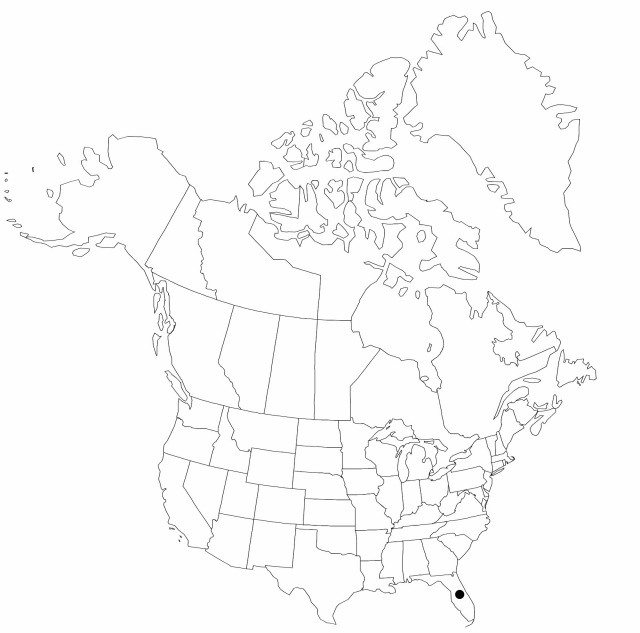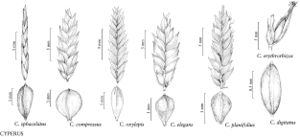Difference between revisions of "Cyperus sphacelatus"
Descr. Pl. Rar., 21. 1772.
FNA>Volume Importer |
imported>Volume Importer |
||
| (5 intermediate revisions by 2 users not shown) | |||
| Line 6: | Line 6: | ||
|place=21. 1772 | |place=21. 1772 | ||
|year=1772 | |year=1772 | ||
| + | }} | ||
| + | |special_status={{Treatment/ID/Special_status | ||
| + | |code=I | ||
| + | |label=Introduced | ||
| + | }}{{Treatment/ID/Special_status | ||
| + | |code=F | ||
| + | |label=Illustrated | ||
}} | }} | ||
|basionyms= | |basionyms= | ||
| Line 11: | Line 18: | ||
|name=Cyperus balbisii | |name=Cyperus balbisii | ||
|authority=Kunth | |authority=Kunth | ||
| + | |rank=species | ||
}} | }} | ||
|hierarchy=Cyperaceae;Cyperus;Cyperus subg. Cyperus;Cyperus sphacelatus | |hierarchy=Cyperaceae;Cyperus;Cyperus subg. Cyperus;Cyperus sphacelatus | ||
| Line 26: | Line 34: | ||
|elevation=0 m | |elevation=0 m | ||
|distribution=Fla.;West Indies;Central America;South America;Africa. | |distribution=Fla.;West Indies;Central America;South America;Africa. | ||
| + | |introduced=true | ||
|tables= | |tables= | ||
|references= | |references= | ||
| Line 34: | Line 43: | ||
-->{{#Taxon: | -->{{#Taxon: | ||
name=Cyperus sphacelatus | name=Cyperus sphacelatus | ||
| − | |||
|authority=Rottbøll | |authority=Rottbøll | ||
|rank=species | |rank=species | ||
| Line 49: | Line 57: | ||
|publication title=Descr. Pl. Rar., | |publication title=Descr. Pl. Rar., | ||
|publication year=1772 | |publication year=1772 | ||
| − | |special status= | + | |special status=Introduced;Illustrated |
| − | |source xml=https:// | + | |source xml=https://bitbucket.org/aafc-mbb/fna-data-curation/src/2e0870ddd59836b60bcf96646a41e87ea5a5943a/coarse_grained_fna_xml/V23/V23_280.xml |
|genus=Cyperus | |genus=Cyperus | ||
|subgenus=Cyperus subg. Cyperus | |subgenus=Cyperus subg. Cyperus | ||
Latest revision as of 20:39, 5 November 2020
Herbs, annual or perennial, cespitose. Culms trigonous, 15–60 cm × 1–3 mm, glabrous. Leaves 2–6, flat to V-shaped, 6–30(–40) cm × 2–4 mm. Inflorescences: spikes broadly ellipsoid, 5–45 × 10–30(–45) mm; rays (2–)5–9, (0.3–)3–10 cm; rachis 4–17 mm; bracts 5–6, horizontal to ascending, V-shaped, 1.5–30 cm × 0.5–4 mm; rachilla persistent, wings hyaline, 0.4–0.5 mm wide. Spikelets 5–30, pale greenish white or stramineous, compressed, linear-lanceoloid, 7–35 × (1.2–)1.4–2 mm; floral scales deciduous, 6–34, spreading or appressed, laterally greenish white, often reddish or brown speckled, medially green, laterally 3–5-ribbed, medially 3-ribbed, elliptic, (2.2–)3–4(–4.4) × (1.2–)1.8–2.2 mm, apex acute. Flowers: anthers 0.6 mm; styles 0.6–1.2 mm; stigmas 1–1.4(–1.7) mm. Achenes reddish brown to dark brown, stipitate, narrowly ellipsoid, 1.4–2 × 0.6–0.9 mm, apex apiculate, surfaces puncticulate.
Phenology: Fruiting summer.
Habitat: Disturbed, wet soils
Elevation: 0 m
Distribution

Introduced; Fla., West Indies, Central America, South America, Africa.
Discussion
Selected References
None.
